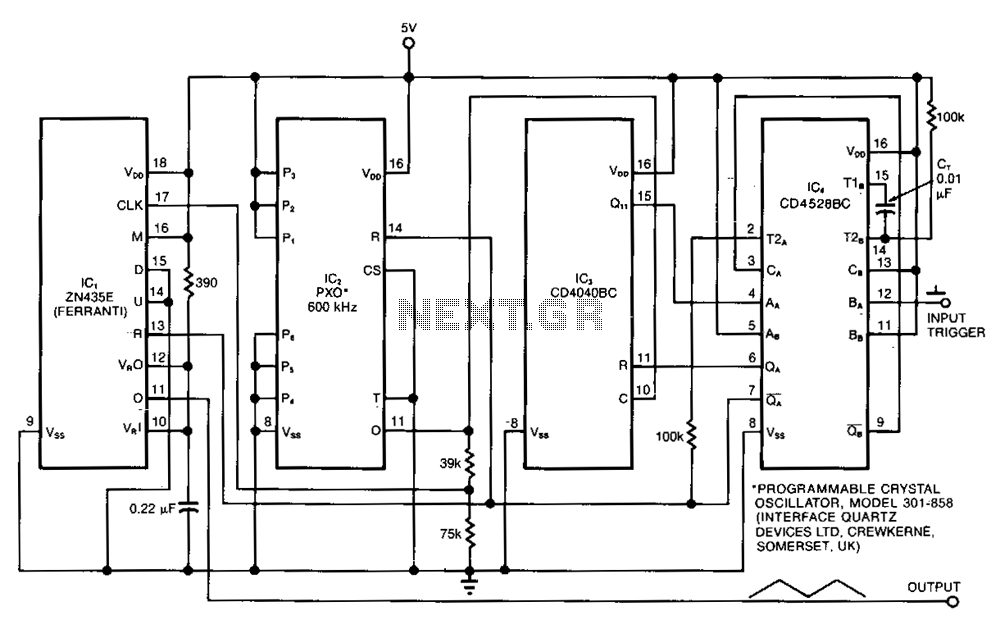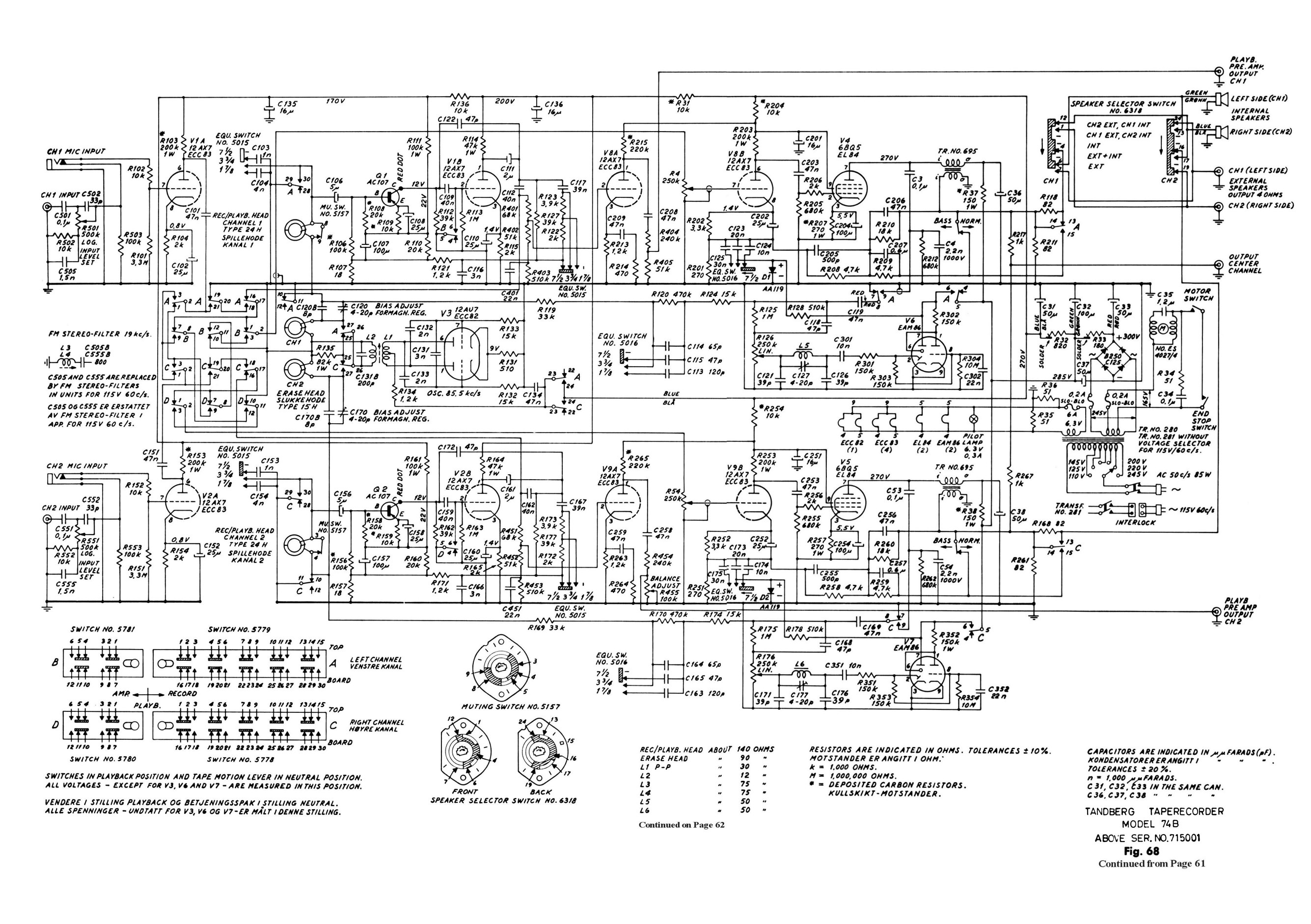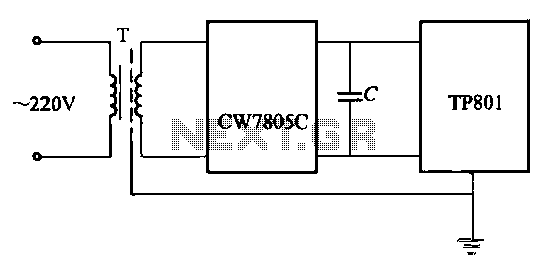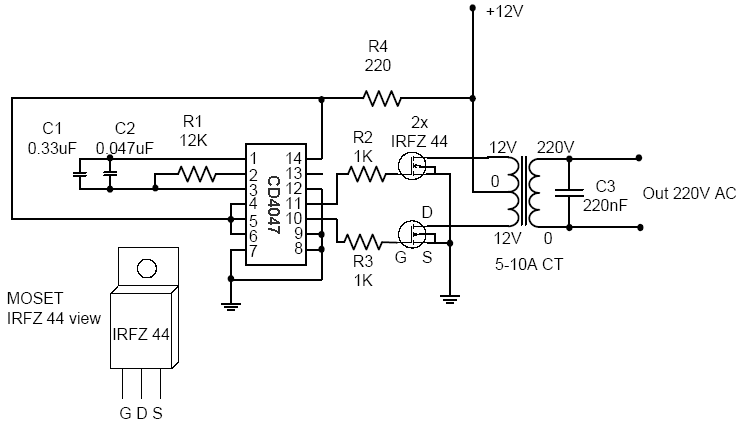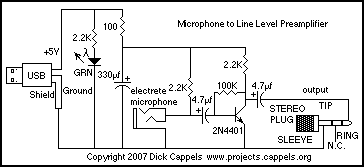
Amp Power Supply More Info
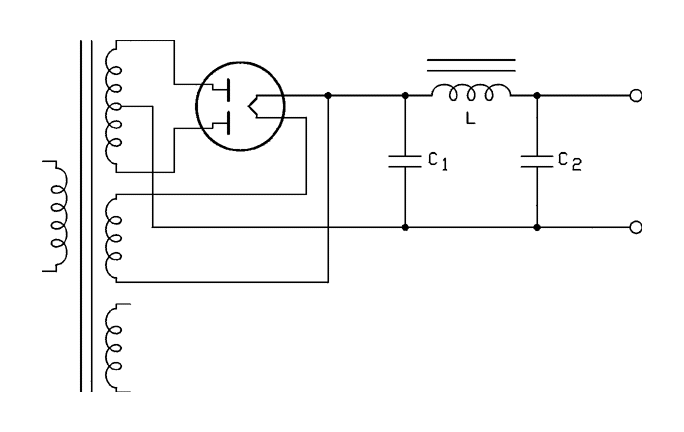
Vacuum tube electronic circuits operate from relatively high DC voltages (150 to 600 volts). The Electric Utility supplies 120 volts AC. Transformers can step up the 120 volts AC line voltage to the necessary range, but it remains AC. Internal circuits in devices such as stereo receivers and oscilloscopes do not operate on AC; they require circuits that convert AC to DC. This conversion circuit is referred to as a "DC power supply," or simply "power supply." A block diagram of a modern low-voltage regulated DC power supply illustrates that each block serves a specific purpose, which will be discussed in separate sections of this chapter. The theoretical principles governing low voltage supplies for transistors and high voltage supplies for tubes are identical. Most audio amplifiers lack a voltage regulator, with additional filtering taking the place of the regulator section in both this book and the power supply. The power supply connects to the 120 volts AC power line via a plug. Many power supplies, particularly those used in laboratory equipment, feature a plug with a third wire that connects the instrument's metal chassis to earth ground. The fuse and switch form the protection circuits; the fuse safeguards the power supply against component failures and incorrect connections, while the switch allows the power supply to be turned on and off. The transformer adjusts the 120 volts of the AC line as needed for the devices being powered. The rectifier converts the AC from the transformer into pulsating DC. The filter minimizes the magnitude of the pulsations and smooths the DC output. The regulator further reduces the pulsations to a negligible level and maintains the output voltage constant, regardless of load current. Additionally, the regulator includes circuits that shut down the power supply if the load current exceeds a certain limit or if the regulator overheats. If the power supply is integrated into devices such as oscilloscopes, FM tuners, or amplifiers, its output is directed to the internal circuits and is not accessible to the user. Conversely, a laboratory bench power supply connects its output to binding posts on the front panel for powering experimental circuits. Such a power supply may also feature a voltmeter and an ammeter for monitoring the supplied voltage and current. All power supplies require protection against overloads and internal faults, with fuses serving as the most apparent protective device. The commonly used fuse consists of a fine metal wire encased in a small glass tube with metal caps for electrical connection. This wire is made from a low melting temperature metal alloy, such as solder (40% lead and 60% tin). If excessive current flows through the fuse, the thin wire melts, breaking the circuit and stopping the current. Fuses are available in ratings from 1/200 ampere to 30 amperes and are typically placed in the primary circuit of the transformer. If a transformer experiences an internal fault, it may catch fire if the power is not cut off by a blown fuse. A fuse should always be present in the primary circuit of a power transformer. Many inexpensive "wall transformers" lack fuses in their primary circuits, creating a constant fire hazard. There are two types of fuses: fast-acting and time-delay (often referred to as slow-blow) fuses. Power supplies equipped with large filter capacitors and semiconductor rectifiers may draw a significant current for a short duration upon activation.
The operation of vacuum tube electronic circuits relies heavily on the conversion of AC voltage to DC voltage, which is crucial for the functionality of various electronic devices. The design of a DC power supply includes several essential components: the transformer, rectifier, filter, and voltage regulator. The transformer is responsible for adjusting the input voltage to the desired level, either stepping it up or down, depending on the requirements of the connected devices.
The rectifier, typically a diode or a bridge rectifier configuration, converts the alternating current (AC) to direct current (DC) by allowing current to flow in one direction only. This process results in pulsating DC, which still contains ripples. The filter circuit, often composed of capacitors and inductors, smooths out these ripples to produce a more stable DC output.
The voltage regulator is a critical component that ensures the output voltage remains consistent despite variations in load current. This is achieved through feedback mechanisms that adjust the output in real-time, maintaining the desired voltage level. Advanced regulators may also incorporate safety features, such as thermal shutdown and current limiting, to prevent damage under fault conditions.
In laboratory environments, bench power supplies are designed with user accessibility in mind, featuring binding posts for easy connection to experimental circuits. The inclusion of monitoring instruments like voltmeters and ammeters allows users to observe real-time measurements of voltage and current, facilitating better control and understanding of the experiments being conducted.
Protection mechanisms, including fuses, are integral to the safety and reliability of power supplies. The selection of appropriate fuse ratings and types is essential to prevent damage from overcurrent situations. Fast-acting fuses are suited for circuits with minimal inrush current, while time-delay fuses are better for applications where brief surges are expected, such as when large capacitors charge.
Overall, understanding the components and operation of a DC power supply is fundamental for designing and troubleshooting electronic circuits, particularly those utilizing vacuum tubes or requiring stable DC voltages for optimal performance.Vacuum tube electronic circuits operate from comparatively high DC voltages (150 to 600 volts). The Electric Utility supplies 120 volts AC. We have studied transformers and, therefore, we know that the 120 vAC line voltage could be stepped up to the necessary range but it would still be AC. The internal circuits of any device you can think of from a stereo receiver to an oscilloscope will not operate on AC. These devices must have internal circuits which change the AC to DC. Such a circuit is called a "DC power supply" or more often just "power supply". Figure 3. 1 shows the block diagram of a modern low-voltage regulated DC power supply. Each block has a specific purpose and will be dealt with in individual sections of this chapter. There is no difference in theory between a low voltage supply for transistors and a high voltage supply for tubes. Most audio amplifiers don`t have a voltage regulator but a section on additional filtering has taken the place of the regulator section both in this book and in the power supply.
The power supply is connected to the 120 vAC power line by a plug. Many power supplies (those used in laboratory equipment) have a plug with a third wire which connects the metal chassis of the instrument to earth ground. The fuse and switch constitute the protection circuits. The fuse helps to protect the power supply against circuit component failures and mistaken connections.
The switch permits the power supply to be turned on and off. The transformer steps the 120 volts of the AC line down or up as required by the devices being powered. The rectifier changes the AC from the transformer to pulsating DC. The filter reduces the magnitude of the pulsations and smoothes out the DC. The regulator reduces the pulsations to a very small value and also holds the output voltage constant regardless of the load current.
The regulator also contains circuits which will shut down the power supply if the load current becomes too large or the temperature of the regulator becomes too high. If the power supply is part of something else, such as an oscilloscope, an FM tuner, or an amplifier the output of the power supply is delivered to the internal circuits of the instrument and is not available to the operator.
If the power supply is a laboratory bench power supply, its output is connected to binding posts on the supply`s front panel for the purpose of powering experimental circuits. A laboratory bench power supply may also include a voltmeter and an ammeter to permit the operator to monitor the voltage and current which are supplied to the load.
All power supplies require protection from overloads and internal circuit faults. The most obvious protection device is a fuse. The type of fuse most commonly used in electronics equipment is a fine metal wire contained in a small glass tube with a metal cap on each end for electrical connection. The wire is made of a metal alloy with a low melting temperature, such as solder (40% led and 60% tin).
If excessive current flows through the fuse the thin metal wire will melt, opening the circuit and turning off the current. Fuses of the type described above are manufactured in current ratings from 1/200 ampere to 30 amperes.
Fuses are often placed in the primary circuit of the transformer. If a transformer develops an internal fault it can catch fire if the power is not shut off by an open fuse. There should always be a fuse in the primary of a power transformer. Many low-cost "wall transformers" do not have fuses in their primary circuits. These units present a constant fire hazard to any building in which they are used. There are two types of fuses, fast-acting and time delay. Time delay fuses are often called slow-blow fuses. Power supplies which have very large filter capacitors and semiconductor rectifiers will draw a very large current for a very short time after being turned on.
Have you ever noticed a flicker of t 🔗 External reference
The operation of vacuum tube electronic circuits relies heavily on the conversion of AC voltage to DC voltage, which is crucial for the functionality of various electronic devices. The design of a DC power supply includes several essential components: the transformer, rectifier, filter, and voltage regulator. The transformer is responsible for adjusting the input voltage to the desired level, either stepping it up or down, depending on the requirements of the connected devices.
The rectifier, typically a diode or a bridge rectifier configuration, converts the alternating current (AC) to direct current (DC) by allowing current to flow in one direction only. This process results in pulsating DC, which still contains ripples. The filter circuit, often composed of capacitors and inductors, smooths out these ripples to produce a more stable DC output.
The voltage regulator is a critical component that ensures the output voltage remains consistent despite variations in load current. This is achieved through feedback mechanisms that adjust the output in real-time, maintaining the desired voltage level. Advanced regulators may also incorporate safety features, such as thermal shutdown and current limiting, to prevent damage under fault conditions.
In laboratory environments, bench power supplies are designed with user accessibility in mind, featuring binding posts for easy connection to experimental circuits. The inclusion of monitoring instruments like voltmeters and ammeters allows users to observe real-time measurements of voltage and current, facilitating better control and understanding of the experiments being conducted.
Protection mechanisms, including fuses, are integral to the safety and reliability of power supplies. The selection of appropriate fuse ratings and types is essential to prevent damage from overcurrent situations. Fast-acting fuses are suited for circuits with minimal inrush current, while time-delay fuses are better for applications where brief surges are expected, such as when large capacitors charge.
Overall, understanding the components and operation of a DC power supply is fundamental for designing and troubleshooting electronic circuits, particularly those utilizing vacuum tubes or requiring stable DC voltages for optimal performance.Vacuum tube electronic circuits operate from comparatively high DC voltages (150 to 600 volts). The Electric Utility supplies 120 volts AC. We have studied transformers and, therefore, we know that the 120 vAC line voltage could be stepped up to the necessary range but it would still be AC. The internal circuits of any device you can think of from a stereo receiver to an oscilloscope will not operate on AC. These devices must have internal circuits which change the AC to DC. Such a circuit is called a "DC power supply" or more often just "power supply". Figure 3. 1 shows the block diagram of a modern low-voltage regulated DC power supply. Each block has a specific purpose and will be dealt with in individual sections of this chapter. There is no difference in theory between a low voltage supply for transistors and a high voltage supply for tubes. Most audio amplifiers don`t have a voltage regulator but a section on additional filtering has taken the place of the regulator section both in this book and in the power supply.
The power supply is connected to the 120 vAC power line by a plug. Many power supplies (those used in laboratory equipment) have a plug with a third wire which connects the metal chassis of the instrument to earth ground. The fuse and switch constitute the protection circuits. The fuse helps to protect the power supply against circuit component failures and mistaken connections.
The switch permits the power supply to be turned on and off. The transformer steps the 120 volts of the AC line down or up as required by the devices being powered. The rectifier changes the AC from the transformer to pulsating DC. The filter reduces the magnitude of the pulsations and smoothes out the DC. The regulator reduces the pulsations to a very small value and also holds the output voltage constant regardless of the load current.
The regulator also contains circuits which will shut down the power supply if the load current becomes too large or the temperature of the regulator becomes too high. If the power supply is part of something else, such as an oscilloscope, an FM tuner, or an amplifier the output of the power supply is delivered to the internal circuits of the instrument and is not available to the operator.
If the power supply is a laboratory bench power supply, its output is connected to binding posts on the supply`s front panel for the purpose of powering experimental circuits. A laboratory bench power supply may also include a voltmeter and an ammeter to permit the operator to monitor the voltage and current which are supplied to the load.
All power supplies require protection from overloads and internal circuit faults. The most obvious protection device is a fuse. The type of fuse most commonly used in electronics equipment is a fine metal wire contained in a small glass tube with a metal cap on each end for electrical connection. The wire is made of a metal alloy with a low melting temperature, such as solder (40% led and 60% tin).
If excessive current flows through the fuse the thin metal wire will melt, opening the circuit and turning off the current. Fuses of the type described above are manufactured in current ratings from 1/200 ampere to 30 amperes.
Fuses are often placed in the primary circuit of the transformer. If a transformer develops an internal fault it can catch fire if the power is not shut off by an open fuse. There should always be a fuse in the primary of a power transformer. Many low-cost "wall transformers" do not have fuses in their primary circuits. These units present a constant fire hazard to any building in which they are used. There are two types of fuses, fast-acting and time delay. Time delay fuses are often called slow-blow fuses. Power supplies which have very large filter capacitors and semiconductor rectifiers will draw a very large current for a very short time after being turned on.
Have you ever noticed a flicker of t 🔗 External reference
